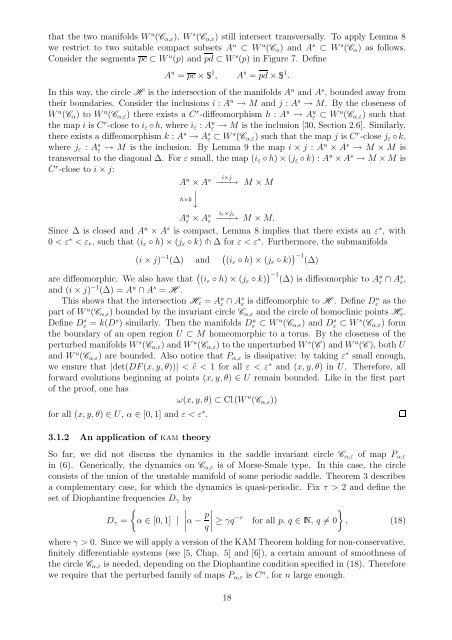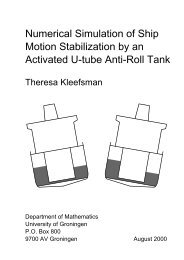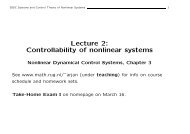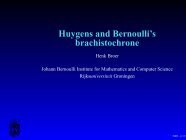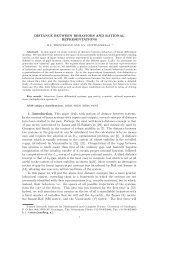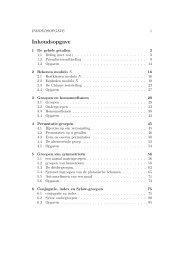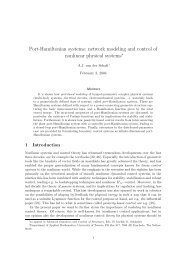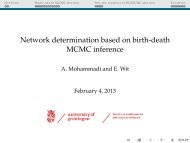Chaos and quasi-periodicity in diffeomorphisms of the solid torus
Chaos and quasi-periodicity in diffeomorphisms of the solid torus
Chaos and quasi-periodicity in diffeomorphisms of the solid torus
You also want an ePaper? Increase the reach of your titles
YUMPU automatically turns print PDFs into web optimized ePapers that Google loves.
that <strong>the</strong> two manifolds W u (C α,ε ), W s (C α,ε ) still <strong>in</strong>tersect transversally. To apply Lemma 8<br />
we restrict to two suitable compact subsets A u ⊂ W u (C α ) <strong>and</strong> A s ⊂ W s (C α ) as follows.<br />
Consider <strong>the</strong> segments pc ⊂ W u (p) <strong>and</strong> pd ⊂ W s (p) <strong>in</strong> Figure 7. Def<strong>in</strong>e<br />
A u = pc × ¡ 1 , A s = pd × ¡ 1 .<br />
In this way, <strong>the</strong> circle H is <strong>the</strong> <strong>in</strong>tersection <strong>of</strong> <strong>the</strong> manifolds A u <strong>and</strong> A s , bounded away from<br />
<strong>the</strong>ir boundaries. Consider <strong>the</strong> <strong>in</strong>clusions i : A u → M <strong>and</strong> j : A s → M. By <strong>the</strong> closeness <strong>of</strong><br />
W u (C α ) to W u (C α,ε ) <strong>the</strong>re exists a C r -diffeomorphism h : A u → A u ε ⊂ W u (C α,ε ) such that<br />
<strong>the</strong> map i is C r -close to i ε ◦ h, where i ε : A u ε → M is <strong>the</strong> <strong>in</strong>clusion [30, Section 2.6]. Similarly,<br />
<strong>the</strong>re exists a diffeomorphism k : A s → A s ε ⊂ W s (C α,ε ) such that <strong>the</strong> map j is C r -close j ε ◦ k,<br />
where j ε : A s ε → M is <strong>the</strong> <strong>in</strong>clusion. By Lemma 9 <strong>the</strong> map i × j : Au × A s → M × M is<br />
transversal to <strong>the</strong> diagonal ∆. For ε small, <strong>the</strong> map (i ε ◦ h) × (j ε ◦ k) : A u × A s → M × M is<br />
C r -close to i × j:<br />
A u × A s i×j<br />
−−−→ M × M<br />
⏐<br />
h×k↓<br />
A u ε × A s i ε×j ε<br />
ε −−−→ M × M.<br />
S<strong>in</strong>ce ∆ is closed <strong>and</strong> A u × A s is compact, Lemma 8 implies that <strong>the</strong>re exists an ε ∗ , with<br />
0 < ε ∗ < ε r , such that (i ε ◦ h) × (j ε ◦ k) ⋔ ∆ for ε < ε ∗ . Fur<strong>the</strong>rmore, <strong>the</strong> submanifolds<br />
(i × j) −1 (∆) <strong>and</strong><br />
(<br />
(iε ◦ h) × (j ε ◦ k) ) −1<br />
(∆)<br />
are diffeomorphic. We also have that ( (i ε ◦ h) × (j ε ◦ k) ) −1 (∆) is diffeomorphic to A u ε ∩ As ε ,<br />
<strong>and</strong> (i × j) −1 (∆) = A u ∩ A s = H .<br />
This shows that <strong>the</strong> <strong>in</strong>tersection H ε = A u ε ∩ As ε is diffeomorphic to H . Def<strong>in</strong>e Du ε as <strong>the</strong><br />
part <strong>of</strong> W u (C α,ε ) bounded by <strong>the</strong> <strong>in</strong>variant circle C α,ε <strong>and</strong> <strong>the</strong> circle <strong>of</strong> homocl<strong>in</strong>ic po<strong>in</strong>ts H ε .<br />
Def<strong>in</strong>e Dε s = k(D s ) similarly. Then <strong>the</strong> manifolds Dε u ⊂ W u (C α,ε ) <strong>and</strong> Dε s ⊂ W s (C α,ε ) form<br />
<strong>the</strong> boundary <strong>of</strong> an open region U ⊂ M homeomorphic to a <strong>torus</strong>. By <strong>the</strong> closeness <strong>of</strong> <strong>the</strong><br />
perturbed manifolds W s (C α,ε ) <strong>and</strong> W u (C α,ε ) to <strong>the</strong> unperturbed W s (C ) <strong>and</strong> W u (C ), both U<br />
<strong>and</strong> W u (C α,ε ) are bounded. Also notice that P α,ε is dissipative: by tak<strong>in</strong>g ε ∗ small enough,<br />
we ensure that |det(DF (x, y, θ))| < ˜c < 1 for all ε < ε ∗ <strong>and</strong> (x, y, θ) <strong>in</strong> U. Therefore, all<br />
forward evolutions beg<strong>in</strong>n<strong>in</strong>g at po<strong>in</strong>ts (x, y, θ) ∈ U rema<strong>in</strong> bounded. Like <strong>in</strong> <strong>the</strong> first part<br />
<strong>of</strong> <strong>the</strong> pro<strong>of</strong>, one has<br />
ω(x, y, θ) ⊂ Cl (W u (C α,ε ))<br />
for all (x, y, θ) ∈ U, α ∈ [0, 1] <strong>and</strong> ε < ε ∗ .<br />
3.1.2 An application <strong>of</strong> kam <strong>the</strong>ory<br />
So far, we did not discuss <strong>the</strong> dynamics <strong>in</strong> <strong>the</strong> saddle <strong>in</strong>variant circle C α,ε <strong>of</strong> map P α,ε<br />
<strong>in</strong> (6). Generically, <strong>the</strong> dynamics on C α,ε is <strong>of</strong> Morse-Smale type. In this case, <strong>the</strong> circle<br />
consists <strong>of</strong> <strong>the</strong> union <strong>of</strong> <strong>the</strong> unstable manifold <strong>of</strong> some periodic saddle. Theorem 3 describes<br />
a complementary case, for which <strong>the</strong> dynamics is <strong>quasi</strong>-periodic. Fix τ > 2 <strong>and</strong> def<strong>in</strong>e <strong>the</strong><br />
set <strong>of</strong> Diophant<strong>in</strong>e frequencies D γ by<br />
{<br />
D γ = α ∈ [0, 1] |<br />
∣ α − p }<br />
q ∣ ≥ γq−τ for all ¡ p, q ∈ , q ≠ 0 , (18)<br />
where γ > 0. S<strong>in</strong>ce we will apply a version <strong>of</strong> <strong>the</strong> KAM Theorem hold<strong>in</strong>g for non-conservative,<br />
f<strong>in</strong>itely differentiable systems (see [5, Chap. 5] <strong>and</strong> [6]), a certa<strong>in</strong> amount <strong>of</strong> smoothness <strong>of</strong><br />
<strong>the</strong> circle C α,ε is needed, depend<strong>in</strong>g on <strong>the</strong> Diophant<strong>in</strong>e condition specified <strong>in</strong> (18). Therefore<br />
we require that <strong>the</strong> perturbed family <strong>of</strong> maps P α,ε is C n , for n large enough.<br />
18


